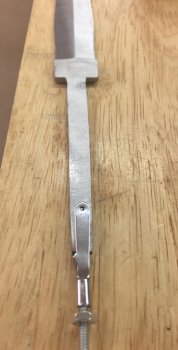C Craft
Well-Known Member
When using a threaded rod for butt cap attachment on a knife, is there a certain type of rod you like to use??? IE, zinc coated, stainless steel, brass, etc. etc.!!
Next question how do you attach the rod/all-thread to the knife or do you attach???
In this tutorial by Mike Carter he shows how he does attachment without weld!!
http://knifedogs.com/showthread.php?4316-No-Weld-Butt-Cap&highlight=tutorial+Mike
Also do you thread the butt cap itself or do you attach/weld a nut to bottom side of the butt cap!!
I am sure there are many ways of doing this process so look forward to hearing discussion on the subject! If your tried something and it failed I would like to know! If you found a better way, I would like to hear of that as well!!
I am working on a knife that is going to have a threaded butt cap and would really appreciate any info that you can share with me!!
Next question how do you attach the rod/all-thread to the knife or do you attach???
In this tutorial by Mike Carter he shows how he does attachment without weld!!
http://knifedogs.com/showthread.php?4316-No-Weld-Butt-Cap&highlight=tutorial+Mike
Also do you thread the butt cap itself or do you attach/weld a nut to bottom side of the butt cap!!
I am sure there are many ways of doing this process so look forward to hearing discussion on the subject! If your tried something and it failed I would like to know! If you found a better way, I would like to hear of that as well!!
I am working on a knife that is going to have a threaded butt cap and would really appreciate any info that you can share with me!!

